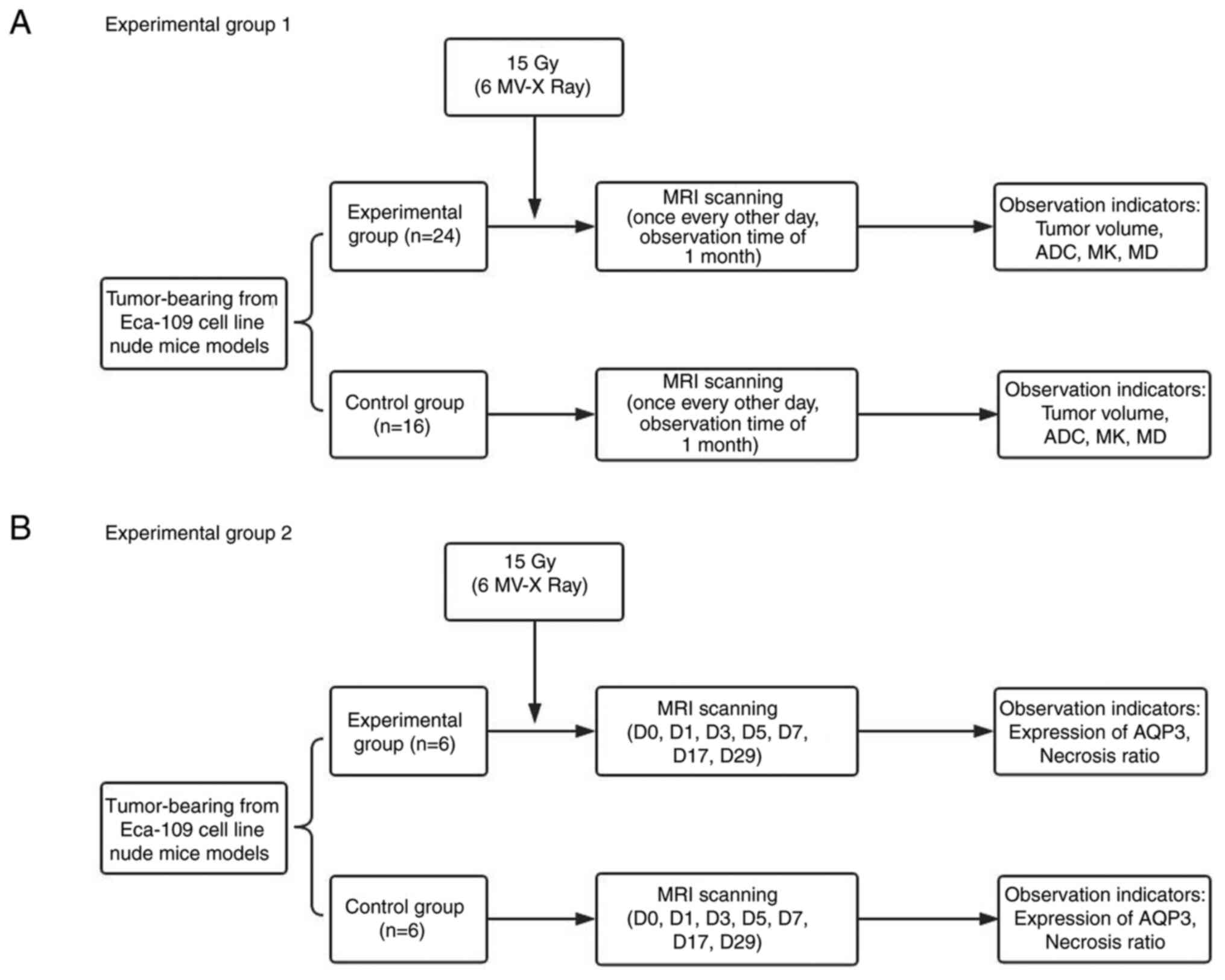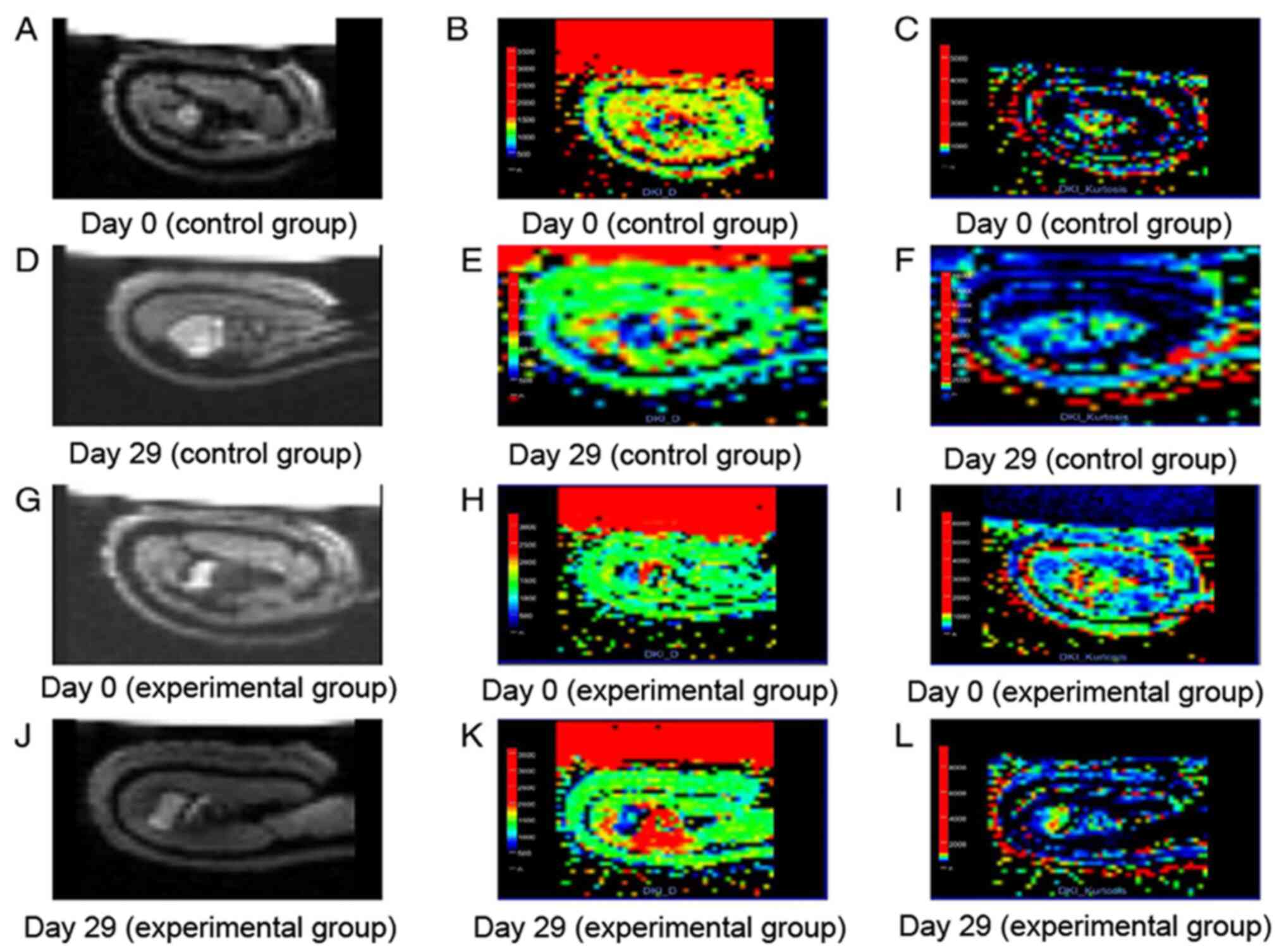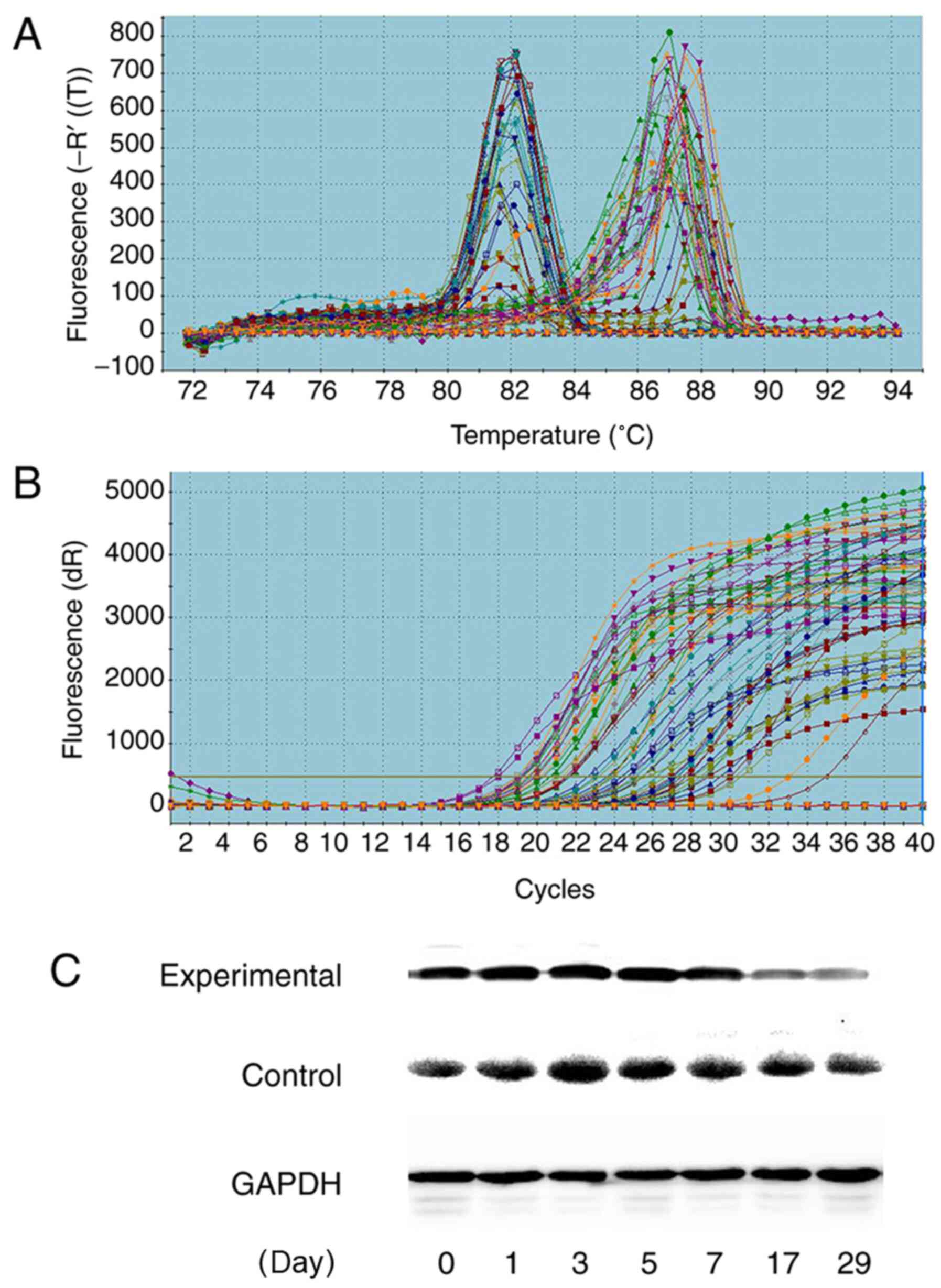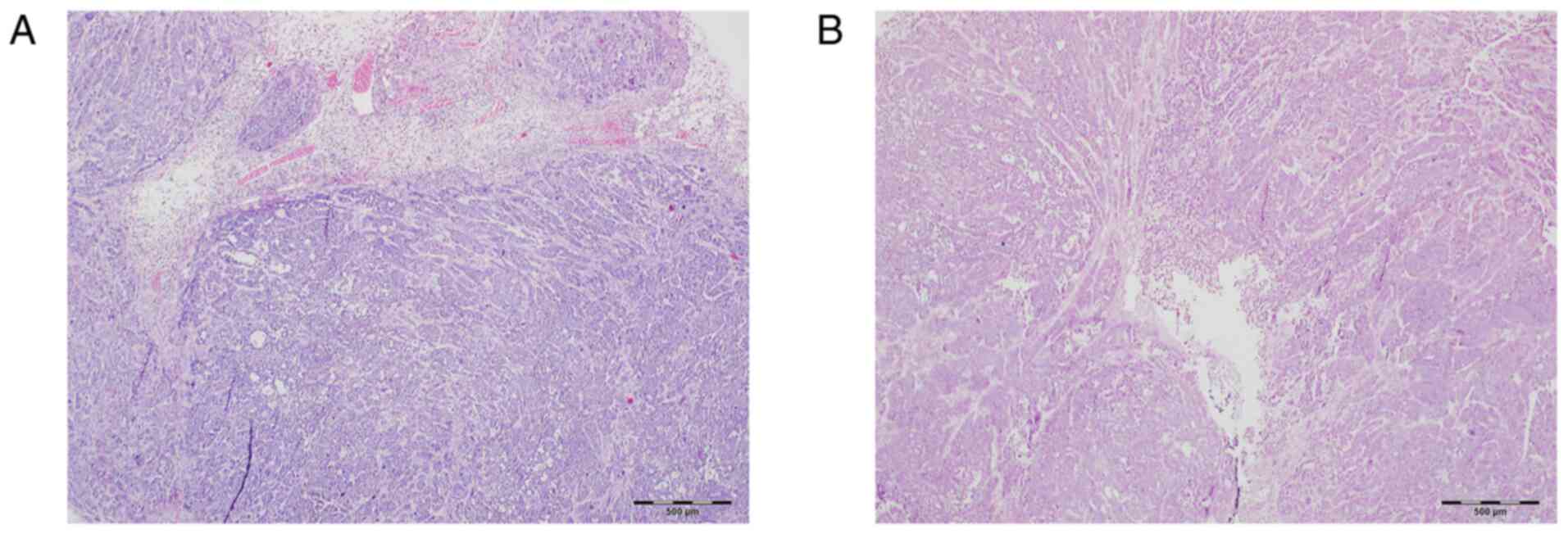|
1
|
Patterson DM, Padhani AR and Collins DJ:
Technology insight: Water diffusion MRI-a potential new biomarker
of response to cancer therapy. Nat Clin Pract Oncol. 5:220–233.
2008.PubMed/NCBI View Article : Google Scholar
|
|
2
|
Lambregts DM, Vandecaveye V, Barbaro B,
Bakers FC, Lambrecht M, Maas M, Haustermans K, Valentini V, Beets
GL and Beets-Tan RG: Diffusion-weighted MRI for selection of
complete responders after chemoradiation for locally advanced
rectal cancer: A multicenter study. Ann Surg Oncol. 18:2224–2231.
2011.PubMed/NCBI View Article : Google Scholar
|
|
3
|
Aoyagi T, Shuto K, Okazumi S, Shimada H,
Kazama T and Matsubara H: Apparent diffusion coefficient values
measured by diffusionweighted imaging predict chemoradiotherapeutic
effect for advanced esophageal cancer. Dig Surg. 28:252–257.
2011.PubMed/NCBI View Article : Google Scholar
|
|
4
|
Jensen JH and Helpern JA: MRI
quantification of non-Gaussian water diffusion by kurtosis
analysis. NMR Biomed. 23:698–710. 2010.PubMed/NCBI View
Article : Google Scholar
|
|
5
|
Sun K, Chen X, Chai W, Fei X, Fu C, Yan X,
Zhan Y, Chen K, Shen K and Yan F: Breast cancer: Diffusion kurtosis
MR imaging-diagnostic accuracy and correlation with
clinicalpathologic factors. Radiology. 277:46–55. 2015.PubMed/NCBI View Article : Google Scholar
|
|
6
|
Agre P, Sasaki S and Chrispeels MJ:
Aquaporins: A family of water channel proteins. Am J Physiol.
265(F461)1993.PubMed/NCBI View Article : Google Scholar
|
|
7
|
King LS and Agre P: Pathophysiology of the
aquaporin water channels. Annu Rev Physiol. 58:619–648.
1996.PubMed/NCBI View Article : Google Scholar
|
|
8
|
Verkman AS: More than just water channels:
Unexpected cellular roles of aquaporins. J Cell Sci. 118:3225–3232.
2005.PubMed/NCBI View Article : Google Scholar
|
|
9
|
Jensen JH, Helpern JA, Ramani A, Lu H and
Kaczynski K: Diffusional kurtosis imaging: The quantification of
non-gaussian water diffusion by means of magnetic resonance
imaging. Magn Reson Med. 53:1432–1440. 2005.PubMed/NCBI View Article : Google Scholar
|
|
10
|
Suo S, Chen X, Wu L, Zhang X, Yao Q, Fan
Y, Wang H and Xu J: Non-Gaussian water diffusion kurtosis imaging
of prostate cancer. Magn Reson Imaging. 32:421–427. 2014.PubMed/NCBI View Article : Google Scholar
|
|
11
|
Nogueira L, Brandão S, Matos E, Nunes RG,
Loureiro J, Ramos I and Ferreira HA: Application of the diffusion
kurtosis model for the study of breast lesions. Eur Radiol.
24:1197–1203. 2014.PubMed/NCBI View Article : Google Scholar
|
|
12
|
Rosenkrantz AB, Sigmund EE, Winnick A,
Niver BE, Spieler B, Morgan GR and Hajdu CH: Assessment of
hepatocellular carcinoma using apparent diffusion coefficient and
diffusion kurtosis indices: Preliminary experience in fresh liver
explants. Magn Reson Imaging. 30:1534–1540. 2012.PubMed/NCBI View Article : Google Scholar
|
|
13
|
Van Cauter S, Veraart J, Sijbers J,
Peeters RR, Himmelreich U, De Keyzer F, Van Gool SW, Van Calenbergh
F, De Vleeschouwer S, Van Hecke W and Sunaert S: Gliomas: Diffusion
kurtosis MR imaging in grading. Radiology. 263:492–501.
2012.PubMed/NCBI View Article : Google Scholar
|
|
14
|
Raab P, Hattingen E, Franz K, Zanella FE
and Lanfermann H: Cerebral gliomas: Diffusional kurtosis imaging
analysis of microstructural differences. Radiology. 254:876–881.
2010.PubMed/NCBI View Article : Google Scholar
|
|
15
|
Rosenkrantz AB, Sigmund EE, Johnson G,
Babb JS, Mussi TC, Melamed J, Taneja SS, Lee VS and Jensen JH:
Prostate cancer: Feasibility and preliminary experience of a
diffusional kurtosis model for detection and assessment of
aggressiveness of peripheral zone cancer. Radiology. 264:126–135.
2012.PubMed/NCBI View Article : Google Scholar
|
|
16
|
Fusco R, Petrillo M, Granata V, Filice S,
Sansone M, Catalano O and Petrillo A: Magnetic resonance imaging
evaluation in neoadjuvant therapy of locally advanced rectal
cancer: A systematic review. Radiol Oncol. 51:252–262.
2017.PubMed/NCBI View Article : Google Scholar
|
|
17
|
Petrillo M, Fusco R, Catalano O, Sansone
M, Avallone A, Delrio P, Pecori B, Tatangelo F and Petrillo A: MRI
for assessing response to neoadjuvant therapy in locally advanced
rectal cancer using DCE-MR and DW-MR data sets: A preliminary
report. Biomed Res Int. 2015(514740)2015.PubMed/NCBI View Article : Google Scholar
|
|
18
|
Pan J, Zang L, Zhang Y, Hong J, Yao Y, Zou
C, Zhang L and Chen Y: Early changes in apparent diffusion
coefficients predict radiosensitivity of human nasopharyngeal
carcinoma xenografts. Laryngoscope. 122:839–843. 2012.PubMed/NCBI View Article : Google Scholar
|
|
19
|
Yuan ZG, Wang ZY, Xia MY, Li FZ, Li Y,
Shen Z and Wang XZ: Comparison of diffusion kurtosis imaging versus
diffusion weighted imaging in predicting the recurrence of early
stage single nodules of hepatocellular carcinoma treated by
radiofrequency ablation. Cancer Imaging. 19(30)2019.PubMed/NCBI View Article : Google Scholar
|
|
20
|
Li T, Hong Y, Kong D and Li K: Histogram
analysis of diffusion kurtosis imaging based on whole-volume images
of breast lesions. J Magn Reson Imaging. 51:627–634.
2020.PubMed/NCBI View Article : Google Scholar
|
|
21
|
Livak KJ and Schmittgen TD: Analysis of
relative gene expression data using real-time quantitative PCR and
the 2(-Delta Delta C(T)) method. Methods. 25:402–408.
2001.PubMed/NCBI View Article : Google Scholar
|
|
22
|
Menglin N, Lan W, Chun H, Liang X, Xuejiao
R, Shutang L, Liu L and Hua T: Experimental study on radiotherapy
response of esophageal cancer xenograft models by
diffusion-weighted magnetic resonance imaging method. Chin J Radiol
Med Prot. 37:896–901. 2017.
|
|
23
|
Xie H, Sun T, Chen M, Wang H, Zhou X,
Zhang Y, Zeng H, Wang J and Fu W: Effectiveness of the apparent
diffusion coefficient for predicting the response to
chemoradiationtherapy in locally advanced rectal cancer: A
systematic review and meta-analysis. Medicine (Baltimore).
94(e517)2015.PubMed/NCBI View Article : Google Scholar
|
|
24
|
Zheng H, Ren W, Pan X, Zhang Q, Liu B, Liu
S, He J and Zhou Z: Role of intravoxel incoherent motion MRI in
early assessment of the response of esophageal squamous cell
carcinoma to chemoradiotherapy: A pilot study. J Magn Reson
Imaging. 48:349–358. 2018.PubMed/NCBI View Article : Google Scholar
|
|
25
|
Giganti F, Salerno A, Ambrosi A, Chiari D,
Orsenigo E, Esposito A, Albarello L, Mazza E, Staudacher C, Del
Maschio A and De Cobelli F: Prognostic utility of diffusion
weighted MRI in oesophageal cancer: Is apparent diffusion
coefficient a potential marker of tumour aggressiveness? Radiol
Med. 121:173–180. 2016.PubMed/NCBI View Article : Google Scholar
|
|
26
|
Liu S, Zhen F, Sun N, Chen J, Cao Y, Zhang
S, Cheng H, Ge X and Sun X: Apparent diffusion coefficient values
detected by diffusion-weighted imaging in the prognosis of patients
with locally advanced esophageal squamous cell carcinoma receiving
chemoradiation. Onco Targets Ther. 9:5791–5796. 2016.PubMed/NCBI View Article : Google Scholar
|
|
27
|
Wang L, Liu L, Han C, Liu S, Tian H, Li Z,
Ren X, Shi G, Wang Q and Wang G: The diffusion-weighted magnetic
resonance imaging (DWI) predicts the early response of esophageal
squamous cell carcinoma to concurrent chemoradiotherapy. Radiother
Oncol. 121:246–251. 2016.PubMed/NCBI View Article : Google Scholar
|
|
28
|
van Rossum PSN, van Hillegersberg R, Lever
FM, Lips IM, van Lier AL, Meijer GJ, van Leeuwen MS, van Vulpen M
and Ruurda JP: Imaging strategies in the management of oesophageal
cancer: What's the role of MRI? Eur Radiol. 23:1753–1765.
2013.PubMed/NCBI View Article : Google Scholar
|
|
29
|
Wu D, Li G, Zhang J, Chang S, Hu J and Dai
Y: Characterization of breast tumors using diffusion kurtosis
imaging (DKI). PLoS One. 9(e113240)2014.PubMed/NCBI View Article : Google Scholar
|
|
30
|
Ou G, Itasaka S, Zeng L, Shibuya K, Yi J,
Harada H and Hiraoka M: Usefulness of HIF-1 imaging for determining
optimal timing of combining bevacizumab and radiotherapy. Int J
Radiat Oncol Biol Phys. 75:463–467. 2009.PubMed/NCBI View Article : Google Scholar
|
|
31
|
Freeman A, Hetzel U, Cripps P and
Mobasheri A: Expression of the plasma membrane markers aquaporin 1
(AQP1), glucose transporter 1 (GLUT1) and Na, K-ATPase in canine
mammary glands and mammary tumours. Vet J. 185:90–93.
2010.PubMed/NCBI View Article : Google Scholar
|
|
32
|
Filli L, Wurnig M, Nanz D, Luechinger R,
Kenkel D and Boss A: Whole-body diffusion kurtosis imaging: Initial
experience on non-Gaussian diffusion in various organs. Invest
Radiol. 49:773–778. 2014.PubMed/NCBI View Article : Google Scholar
|
|
33
|
Zhu L, Pan Z, Ma Q, Yang W, Shi H, Fu C,
Yan X, Du L, Yan F and Zhang H: Diffusion kurtosis imaging study of
rectal adenocarcinoma associated with histopathologic prognostic
factors: Preliminary findings. Radiology. 284:66–76.
2017.PubMed/NCBI View Article : Google Scholar
|
|
34
|
Liu X, Zhou L, Peng W, Wang H and Zhang Y:
Comparison of stretched-exponential and monoexponential model
diffusion-Weighted imagingin prostate cancer and normal tissues. J
Magn Reson Imaging. 42:1078–1085. 2015.PubMed/NCBI View Article : Google Scholar
|
|
35
|
Zheng X, Chen Y, Xiao Y, Zheng D and Chen
W: Early diagnosis of radio-insensitive human nasopharyngeal
carcinoma xenograft models bydiffusion kurtosis imaging. Magn Reson
Imaging. 55:128–132. 2019.PubMed/NCBI View Article : Google Scholar
|
|
36
|
Hu F, Tang W, Sun Y, Wan D, Cai S, Zhang
Z, Grimm R, Yan X, Fu C, Tong T and Peng W: The value of diffusion
kurtosis imaging in assessing pathological complete response to
neoadjuvant chemoradiation therapy in rectal cancer: A comparison
with conventional diffusion-weighted imaging. Oncotarget.
8:75597–75606. 2017.PubMed/NCBI View Article : Google Scholar
|
|
37
|
Verkman AS, Hara-Chikuma M and
Papadopoulos MC: Aquaporins-new players in cancer biology. J Mol
Med (Berl). 86:523–529. 2008.PubMed/NCBI View Article : Google Scholar
|
|
38
|
Papadopoulos MC, Saadoun S and Verkman AS:
Aquaporins and cell migration. Pflugers Arch. 456:693–700.
2008.PubMed/NCBI View Article : Google Scholar
|
|
39
|
Hu J and Verkman AS: Increased migration
and metastatic potential of tumor cells expressing aquaporin water
channels. FASEB J. 20:1892–1894. 2006.PubMed/NCBI View Article : Google Scholar
|
|
40
|
Kusayama M, Wada K, Nagata M, Ishimoto S,
Takahashi H, Yoneda M, Nakajima A, Okura M, Kogo M and Kamisaki Y:
Critical role of aquaporin 3 on growth of human esophageal and oral
squamous cell carcinoma. Cancer Sci. 102:1128–1136. 2011.PubMed/NCBI View Article : Google Scholar
|
|
41
|
Nico B, Mangieri D, Tamma R, Longo V,
Annese T, Crivellato E, Pollo B, Maderna E, Ribatti D and Salmaggi
A: Aquaporin-4 contributes to the resolution of peritumoural brain
oedema in human glioblastoma multiforme after combined chemotherapy
and radiotherapy. Eur J Cancer. 45:3315–3325. 2009.PubMed/NCBI View Article : Google Scholar
|
|
42
|
Tan Y, Zhang H, Wang XC, Qin JB and Wang
L: The value of multi ultra high-b-value DWI in grading cerebral
astrocytomas and its association with aquaporin-4. Br J Radiol.
91(20170696)2018.PubMed/NCBI View Article : Google Scholar
|
|
43
|
Kong L, Lian G, Zheng W, Liu H, Zhang H
and Chen R: Effect of alcohol on diffuse axonal injury in rat
brainstem: Diffusion tensor imaging and aquaporin-4 expression
study. Biomed Res Int. 2013(798261)2013.PubMed/NCBI View Article : Google Scholar
|
|
44
|
Yao X, Derugin N, Manley GT and Verkman
AS: Reduced brain edema and infarct volume in aquaporin-4 deficient
mice after transient focal cerebral ischemia. Neurosci Lett.
584:368–372. 2015.PubMed/NCBI View Article : Google Scholar
|
|
45
|
Zhong J, Shi P, Chen Y, Huang R, Xiao Y,
Zheng X, Zheng D and Peng L: Diffusion kurtosis imaging of a human
nasopharyngeal carcinoma xenograft model: Initial experience with
pathological correlation. Magn Reson Imaging. 47:111–117.
2018.PubMed/NCBI View Article : Google Scholar
|
|
46
|
Zheng X, Chen Y, Zheng D, Xiao Y, Chen J,
Pan J and Chen W: Diffusion kurtosis imaging and tumour
microstructure for monitoring response to radiotherapy in human
nasopharyngeal carcinoma xenografts. Jpn J Clin Oncol. 50:548–555.
2020.PubMed/NCBI View Article : Google Scholar
|
|
47
|
Yang SH, Lin J, Lu F, Han ZH, Fu CX, Lv P,
Liu H and Gao DM: Evaluation of antiangiogenic and
antiproliferative effects of sorafenib by sequential histology and
intravoxel incoherent motion diffusion-weighted imaging in an
orthotopic hepatocellular carcinoma xenograft model. J Magn Reson
Imaging. 45:270–280. 2017.PubMed/NCBI View Article : Google Scholar
|
|
48
|
Guo R, Yang SH, Lu F, Han ZH, Yan X, Fu
CX, Zhao ML and Lin J: Evaluation of intratumoral heterogeneity by
using diffusion kurtosis imaging and stretched exponential
diffusion-weighted imaging in an orthotopic hepatocellular
carcinoma xenograft model. Quant Imaging Med Surg. 9:1566–1578.
2019.PubMed/NCBI View Article : Google Scholar
|
|
49
|
Zhu L, Cheng Q, Luo W, Bao L and Guo G: A
comparative study of apparent diffusion coefficient and intravoxel
incoherent motion-derivedparameters for the characterization of
common solid hepatic tumors. Acta Radiol. 56:1411–1418.
2015.PubMed/NCBI View Article : Google Scholar
|
|
50
|
Liu G, Yang Z, Li T, Yang L, Zheng X and
Cai L: Optimization of b-values in diffusion-weighted imaging for
esophageal cancer: Measuring the longitudinal length of gross tumor
volume and evaluating chemoradiotherapeutic efficacy. J Cancer Res
Ther. 13:748–755. 2017.PubMed/NCBI View Article : Google Scholar
|














